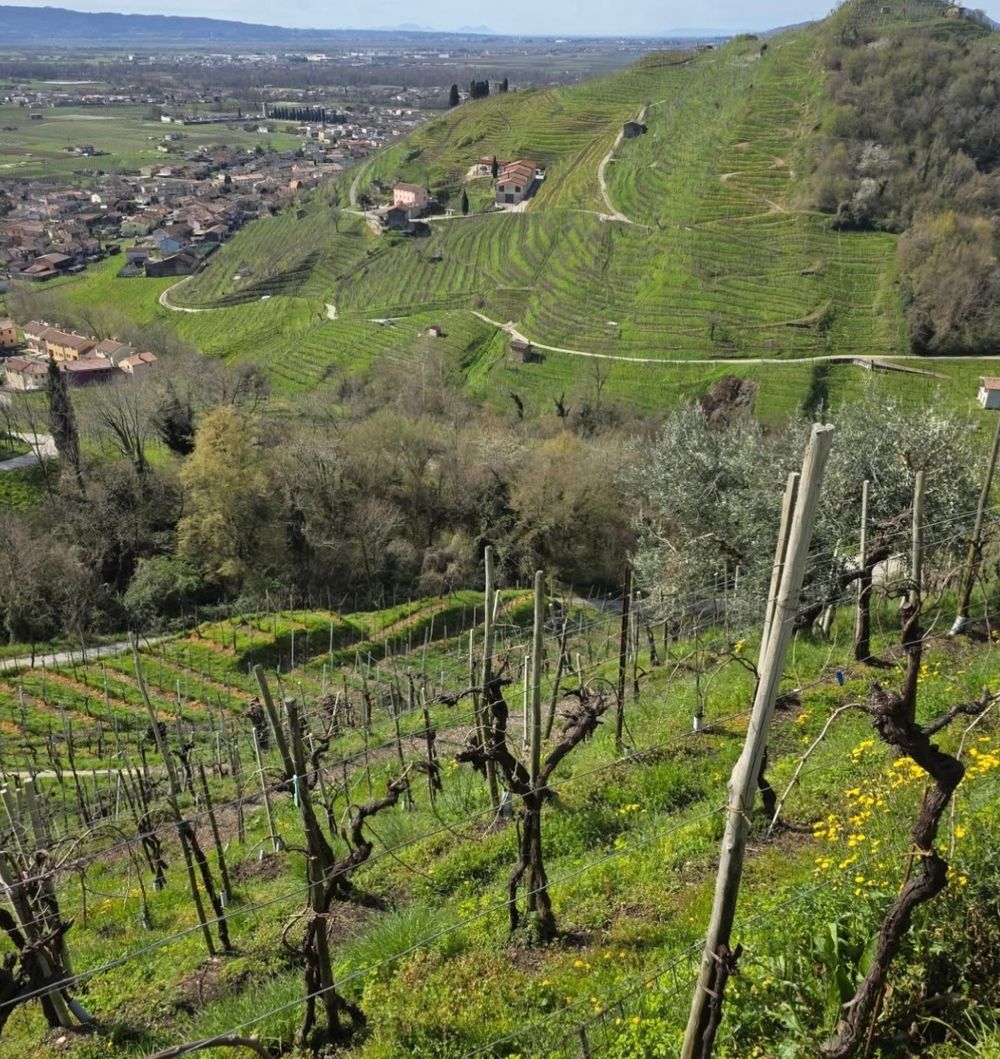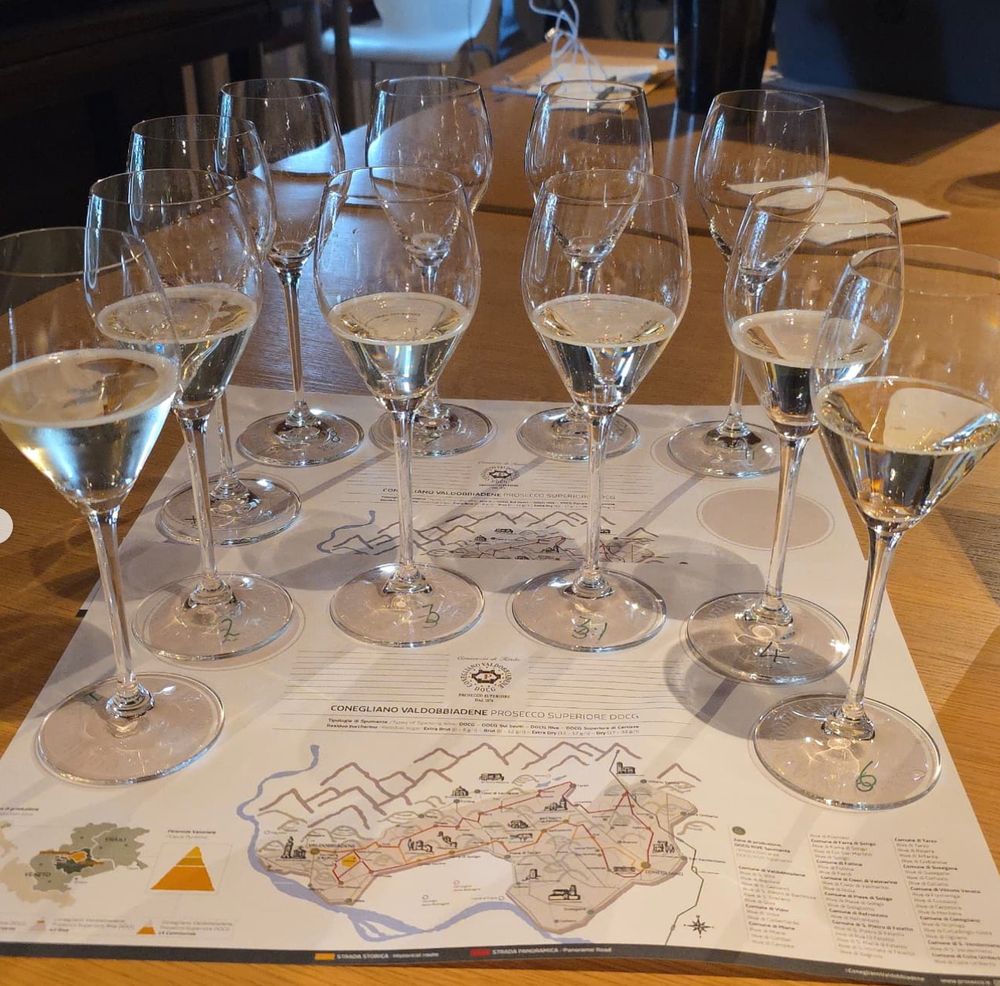To truly understand a place, there is no substitute for going there. Nowhere is this more true than in the verdant, vine-covered hills between the northern Italian towns of Conegliano and Valdobbiadene, just over an hour north of Venice.
In this region, which is home to the highest quality Prosecco Superiore DOCG wines, winemakers talk about ‘viticoltura eroica’ (heroic viticulture), where the free-draining, steep slopes demand around 800 hours of manual labour per year – a stark contrast to the mere 100 or so required for the flat plains we can see spread out below us.

The dramatic hills and landscape of the Prosecco Superiore DOCG region
As I look down post tasting from an ancient, hillside ‘casera’; one of many old stone shelters in the area, it’s hard to believe that these ‘Superiore’ wines were only officially granted DOCG status in 2009.
This includes Cartizze – the jewel in Prosecco’s crown, which has been regarded unofficially as its ‘grand cru’ growing area since the hedonism and glamour of old Venice back in the 1800s.
With a thoughtfully arranged programme of key producer visits and tastings, all timed around the judging sessions and complemented by some fabulous characters and local food to boot, our crack team of judges were perfectly primed to blind taste Prosecco with freshly open minds and a sense of curiosity.
“It’s a particularly respectful way to judge,” says IWSC committee head judge Sarah Abbott MW. “Coming here reminds you how context and cultural meaning are just as important as a wine’s intrinsic qualitative attributes. Especially in regions where wine is so deeply woven into the culture of a place. And tasting sparkling wine is particularly demanding, even for the most experienced judges,” she adds.
“The personality and character of Prosecco is breezy and joyous, but delicate. The nuances are there, and they are finely differentiated. It’s a task that requires high focus and sustained concentration, but everyone more than rose to the challenge.”
Global judging

The IWSC Global Judging Progam is a chance for leading UK buyers to work with the IWSC to visit countries and wine regions and taste wines in situ around the world
Indeed, the IWSC’s global programme appears to be going from strength to strength, with strong support from its associated judges and regional partners around the world.
“Recognising the growing demand for deeper engagement with our judges, we launched the Global Judging Programme in 2022 and have since expanded to host 10 global judging events annually,” says Christelle Guibert, chief executive of fine wines and spirits at The Conversion Group, which owns the IWSC.
“The programme immerses judges in the regions or countries they are assessing, while maintaining the same rigorous IWSC judging standards found in London. Each judge returns with new perspectives, consistently finding the trips to be eye-opening experiences - helping them become ambassadors for the region.
“For producers, it’s an opportunity to build relationships with influential judges, most of whom are buyers, and gain insights into the UK wine industry.”
Impressive steps
This was the IWSC’s second visit to Conegliano-Valdobbiadene, with the focus solely on its Prosecco Superiore DOCG wines across all the incongruously named sweetness levels as well as the region’s 43 single-slope Rive terroirs and a selection of impressive, and incredibly moreish, ancestral method wines. Traditionally known as Col Fondo, producers are increasingly referring to these unfiltered wines as Sui Lieviti, which translates as “on lees” - and it’s a style that appears to be gaining momentum among serious producers, with many examples showing excellent ageing potential.

The IWSC judges were impressed by the consistent quality across the Superiore DOCG wines they tasted
“I’d like to see more of the Sui Lieviti wines, as I think it’s a really positive category that can help rebuild Prosecco’s fine wine reputation,” says wine writer and fellow judge Jason Millar. “The progress that’s been made with the Brut wines is also really impressive. There’s a lot of potential there, and I believe it’s something that helps set the DOCG wines apart from the DOC,” he adds.
Another key takeaway from the judging panel, which included sommeliers Melania Battiston and Vincenzo Arnese, experienced buyers Cat Lomax and Megan Clarke, was the relatively new Rive category is one to watch. These wines are often made in the Extra Brut style, with little to no sugar, allowing plenty of room to showcase nuances from the region’s unique terroirs and microclimates.
“The difference between ‘buono’ and ‘buonissimo’, where the ‘issimo’ means surprise,” as winemaker Umberto Marchiori explained on day one.
A stronger focus on sustainability and vineyard biodiversity, along with a resurgence of the region’s other native grapes to add nuance to the blend (Verdiso, Perera, Bianchetta and Glera Lunga) is another reason to ‘look for the G’ and broaden our Prosecco horizons.
With six golds, 52 silvers and 61 bronze medals awarded from 127 wines tasted blind, there is clearly much to discover and celebrate when it comes to the wines of Conegliano Valdobbiadene Prosecco Superiore DOCG - even if one of those things isn’t the length of its name.
* Helena Nicklin is a judge for the IWSC. The full results of the 2025 Conegliano Valdobbiadene Prosecco Superiore DOCG judging, in partnership with Consorzio di Tutela del Conegliano Valdobbiadene Prosecco Superiore DOCG, can be seen here: Results Revealed: IWSC Judging in Conegliano Valdobbiadene | IWSC.
You can read more about IWSC’s Global Judging campaign here: Global Judging | IWSC International Wine & Spirit Competition.
































